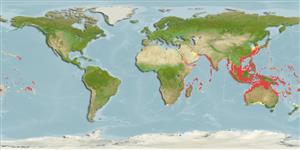分類 / Names
共通名の | 類義語 | Catalog of Fishes(部類, 種) | ITIS | CoL | WoRMS | Cloffa
>
Scombriformes (Mackerels) >
Scombridae (Mackerels, tunas, bonitos) > Scombrinae
Etymology: Euthynnus: Greek, eu = good + Greek, thynnos = tunna (Ref. 45335).
Environment: milieu / climate zone / depth range / distribution range
生態学
海; 海洋回遊性 (Ref. 51243); 深さの範囲 0 - 200 m (Ref. 54439). Tropical; 18°C - 29°C (Ref. 168); 35°N - 38°S, 19°E - 137°W (Ref. 54439)
Indo-West Pacific: in warm waters including oceanic islands and archipelagos. A few stray specimens have been collected in the Eastern Central Pacific. Highly migratory.
Length at first maturity / サイズ / 重さ / 年齢
Maturity: Lm 42.3, range 40 - 65 cm
Max length : 100.0 cm FL オス/雌雄の選別がない; (Ref. 168); common length : 60.0 cm FL オス/雌雄の選別がない; (Ref. 168); 最大公表体重: 14.0 kg (Ref. 30874); 最大記録サイズ: 6 年 (Ref. 121508)
背面の脊椎 (合計) : 10 - 15; 背鰭 (合計) : 11 - 15; 肛門の骨: 0; 臀鰭: 11 - 15; 脊つい: 39. This species is distinguished by the following characters: medium-sized fish with a robust, elongate and fusiform body; teeth small and conical, in a single series; total gill rakers on first gill arch 29-34; D1 XI-XIV with both dorsal fins separated by only a narrow interspace (not wider than eye), anterior spines of first fin much higher than those midway, giving fin a strongly concave outline; D2 much lower than first and followed by 8-10 finlets; anal fin followed by 6-8 finlets; pectoral fins short, never reaching interspace between dorsal fins; 2 flaps (interpelvic process) between pelvic fins; very slender caudal peduncle with a prominent lateral keel between 2 small keels at base of caudal fin; body naked except for corselet and lateral line. Colour of back dark blue with a complicated striped pattern which does not extend forward beyond middle of first dorsal fin; lower sides and belly silvery white; several characteristic dark spots between pelvic and pectoral fins (but may not always be present) (Ref. 9684, 90102).
Occurs in open waters but always remains close to the shoreline. The young may enter bays and harbors. Forms multi-species schools by size with other scombrid species comprising from 100 to over 5,000 individuals. A highly opportunistic predator feeding indiscriminately on small fishes, especially on clupeoids and atherinids; also on squids, crustaceans and zooplankton. Caught in multispecies fisheries, mainly by surface trolling; also with gill nets. Generally marketed canned and frozen; also utilized dried, salted, smoked and fresh (Ref. 9684).
Collette, B.B. and C.E. Nauen, 1983. FAO Species Catalogue. Vol. 2. Scombrids of the world. An annotated and illustrated catalogue of tunas, mackerels, bonitos and related species known to date. Rome: FAO. FAO Fish. Synop. 125(2):137 p. (Ref. 168)
人間に対する脅威
Reports of ciguatera poisoning (Ref. 30911)
Human uses
水産業: 高い商業の; ゲームフィッシュ: はい
用具
特記事項
XMLをダウンロードして下さい
インターネットの情報源
Estimates based on models
Preferred temperature (Ref.
123201): 20.7 - 28.5, mean 26.9 °C (based on 1384 cells).
Phylogenetic diversity index (Ref.
82804): PD
50 = 0.6250 [Uniqueness, from 0.5 = low to 2.0 = high].
Bayesian length-weight: a=0.01000 (0.00862 - 0.01160), b=3.05 (3.01 - 3.09), in cm total length, based on LWR estimates for this species (Ref.
93245).
栄養段階 (Ref.
69278): 4.5 ±0.0 se; based on diet studies.
Generation time: 1.6 (1.2 - 2.5) years. Estimated as median ln(3)/K based on 11
growth studies.
回復力 (Ref.
120179): 手段, 1.4年~4.4年の倍増期間の最小個体群 (K=0.4-0.5; tm=3; Fec=210,000).
Prior r = 0.88, 95% CL = 0.58 - 1.32, Based on 5 full stock assessments.
Fishing Vulnerability (Ref.
59153): Moderate vulnerability (36 of 100).
Climate Vulnerability (Ref.
125649): High to very high vulnerability (75 of 100).
Nutrients (Ref.
124155): Calcium = 20.9 [9.6, 171.3] mg/100g; Iron = 2.28 [0.88, 5.97] mg/100g; Protein = 23.1 [21.1, 24.7] %; Omega3 = 0.235 [0.129, 0.428] g/100g; Selenium = 70.6 [35.4, 143.5] μg/100g; VitaminA = 20.2 [5.4, 77.8] μg/100g; Zinc = 0.408 [0.211, 1.643] mg/100g (wet weight); based on
nutrient studies.
